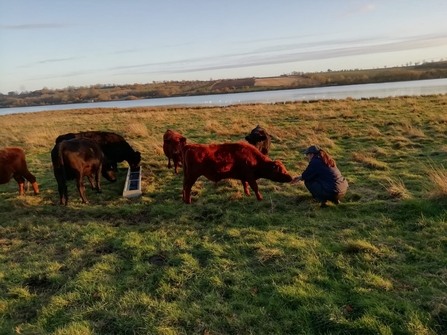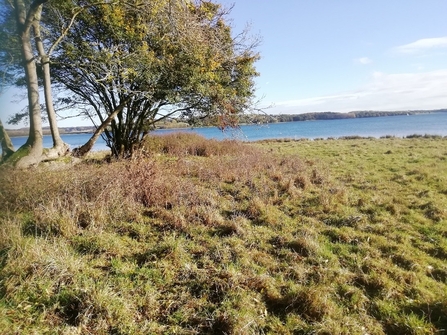The livestock at Rutland Water Nature Reserve are one of our most dedicated groups of volunteers, working 24/7 to ensure our wildflower meadows, wet grasslands, and lagoon margins remain healthy in the desired conditions for the wildlife that depends on their management.
Grazing at Rutland Water Nature Reserve

Leicestershire and Rutland Wildlife Trust own 17 Dexter cattle and 65 Hebridean sheep for the management of Rutland Water. Both breeds have been selected for their hardiness and ability to thrive on low nutritional value grasslands.
The Dexters are also ideal for our wetland nature reserve as their small size reduces the impact on fragile ground. Late summer and through the autumn is the busiest time of year for moving the livestock around the reserve with movements taking place as often as monthly.
From August, the sheep are used to graze our wildflower meadows from which hay is cut in July. Once the hay has been cut and removed and the seasons get a bit more moisture on the ground, the grass begins its ‘autumn flush’ of growth which, depending on weather conditions could be as much as 15cm of growth during a mild Autumn.
The main job of the sheep is to keep the grass height down to below 5cms before the end of November. This enables any early flowering wildflower species such as lesser celandine and violets to thrive in the hedgerow bottoms anytime from February, providing an important early food source for insects.

Also, during this time the sheep are vital for grazing many of the grasslands that are favoured by our wintering wigeon.
Wigeon are grazing ducks, and during winter, Rutland Water Nature Reserve sees internationally important numbers wintering at the reserve. They love short, tightly grazed open grasslands created by the grazing technique of sheep nibbling close to the ground.
The aim is to have most areas in favourable condition by October, as the wigeon numbers at the reserve start to increase. The sheep have some serious munching to do to keep both the wigeon and the wildflowers happy!

Wigeon - Chris Gomersall/2020VISION
Once November is upon us, the sheep are moved off the wildflower areas so they don’t damage the ground during the wetter, winter months.
The cattle have even more work to do than the sheep. From August, they are vital for the management of our species-rich grasslands that are not cut for hay. These grasslands provide important foraging areas for insects, mammals, and birds through the Autumn, but also need the summer's growth of vegetation to be removed to reduce nutrient build-up.
Cows are the perfect tool. They graze by wrapping their tongue around tall vegetation and pulling, this type of grazing creates a mosaic of sward (vegetation) structure within the grassland, from bare soil to short grass, long grass, and thicker tussocks, which also creates sheltered sunny spots and open feeding areas for all sorts of wildlife to take refuge.
If this management was done with just machinery, the diverse structure of the grassland would be lost, although some machinery use is vital to ensure woody species such as blackthorn are not encroaching into the grasslands from surrounding hedgerows.
Once the cows have been moved around all of these grasslands, they then have to go around again to clear up the Autumn flush of growth. All that constant eating must be hard work for them!

Cattle grazing creates structure diversity within a grassland
The cows are also used to graze the wet ditch and grassland areas that fringe lagoons 1 and 2. Here, their job is to battle their way through encroaching willow and typha, munching as they go, to ensure the shoreline is kept open and muddy for dabbling wildfowl and the waders on their way to their wintering feeding grounds

